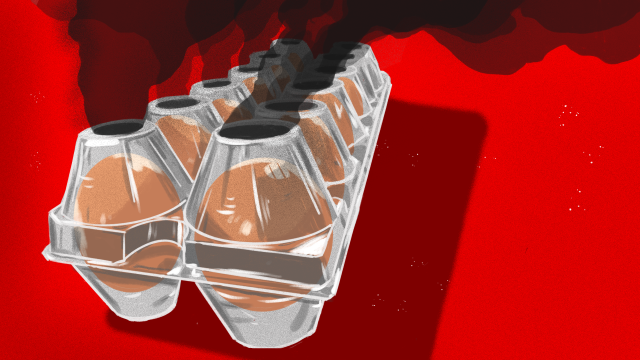Choosing which eggs to buy at the grocery store can be an overwhelming process. Single A, Double A, jumbo, organic, free range, cage free, pasture-raised, vegetarian-fed, hormone-free, certified humane, local and antibiotic-free are among the befuddling labels facing shoppers on store shelves.
But it’s not just the type of eggs that can be confusing, it’s also how they’re packaged. Add polystyrene, paper, or plastic carton to the egg quandary facing consumers.
An increasing number of egg purveyors in the U.S. are switching to plastic tri-fold cartons. The shift toward plastic containers comes at a moment when single-use plastic consumption is creating a pollution crisis.
China’s decision to halt importing most of the world’s recyclable materials in 2017 led to a collapse of an American recycling industry unprepared to deal with its own waste. Without a market to sell its recyclables, local municipalities cut back or stopped recycling altogether, leading some American cities to burn their plastic waste.
Plastics have built up in the environment and are remote floes of Arctic ice.
So why are plastic-encased eggs now showing up on American store shelves by the dozen?
Egg companies have turned to like the plastic packaging for a few reasons. They say American customers like the product visibility through the clear carton.
Plastic packaging also allows for flashier labelling and reduces the number of eggs broken in transit. Pete and Gerry’s, Organic Valley, Nature’s Yoke, Eggland’s Best, the Farmers Hen and Sauders are among the major U.S. brands now using plastic cartons.
But the part that doesn’t sit well is the claim that rPET (recycled plastic) packaging is more environmentally friendly. Egg purveyors point to a near decade old life cycle analysis comparing different types of egg packaging, which concluded that rPET has the lowest environmental impact. The analysis ” which was commissioned by Canadian packaging company Interplast, now owned by Pactiv ” bases its conclusion on 2011 recycling rates that have since become obsolete.
“Using an eight-year old study as a basis for important sustainability decisions is certainly a stretch,” Christoph Meinrenken, a scientist who specialises in life cycle analyses, told Gizmodo. “Particularly since the study itself stresses that the recycling circumstances were crucial for whether the plastic or pulp option comes out on top in the sustainability comparison.”
The egg carton analysis was also done for very specific egg cartons made by particular carton manufacturers in Quebec. The results may not be representative for manufacturers in regions outside of the province.
Egg companies that specialise in humane and ethically-produced eggs have led the shift toward plastic egg packaging. For values-based shoppers, this presents a moral dilemma: a binary between purchasing single-use plastic or a potentially lower quality egg.
Pete and Gerry’s Organic Eggs, which also owns Nellie’s Free Range Eggs, is a New Hampshire-based egg supplier and certified B Corporation, meaning the company meets the highest standards of social and environmental responsibility.
The company was already using plastic containers for its eggs when the life cycle analysis made its conclusion, and it told Gizmodo it felt validated by the study’s findings in it’s decision to use rPET packaging.
Some purveyors, like Pennsylvania-based Sauders Eggs (which was also using plastic before the study was conducted) cite the environmental benefit of using rPET on their website while actually using virgin plastic ” the most carbon-intensive form of egg packaging ” to create their molds.
Egg company the Country Hen announced a switch to plastic in 2017, citing sustainability as one reason behind their decision. The company uses virgin plastic while touting the recyclability of its packaging, something that’s become increasingly difficult in the wake of China’s decision to not accept most foreign recyclable plastics last year.
If egg decisions at the store weren’t already difficult enough to parse, the duplicitous advertising is enough to cause a headache for even the most discerning of shoppers.
Trafficking in eggs is fragile business and losing them to breakage has an environmental impact, too. Paul Turbeville, vice president of marketing for Pete and Gerry’s, told Gizmodo that with the plastic packaging, his company has a breakage rate of less than one per cent. That less than the 2-3 per cent loss rates he said are common for retailers using pulp cartons.
Turbeville acknowledged the study Pete and Gerry’s leans on for its packaging decisions is outdated and said they are evaluating alternatives. While his company wants to do right by the environment, Turbeville said Pete and Gerry’s hasn’t yet felt buyers turn away from them due to their plastic packaging.
Without a new life cycle analysis of cartons with up-to-date inputs or pressure from consumers, why change? There is no regulatory framework for who should conduct a new life cycle analysis or how often they should occur, but according to Meinrenken, the best practice would be for the egg carton manufacturers themselves to carry out an updated life cycle analysis.
“The impetus to do the life cycle study may come from customers or egg farms,” Meinrenken said. “Why would a company want to make important decisions such as which packaging option to use if those decisions are not based on up-to-date information? They shouldn’t ” and customers should demand better, more recent information.”
It’s high time for a new life cycle analysis to be conducted, with inputs that reflect the reality of today’s recycling system that’s been strained to the breaking point. It’s also time for all consumers to add package criteria to their purchasing decisions.
Peter is a New York City-based writer focused on human impacts on natural systems. He is a former Coast Guard officer and holds a Masters in Climate and Society from Columbia University.
